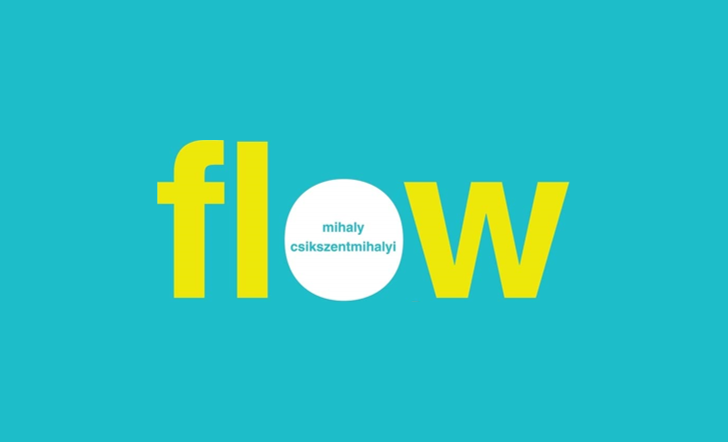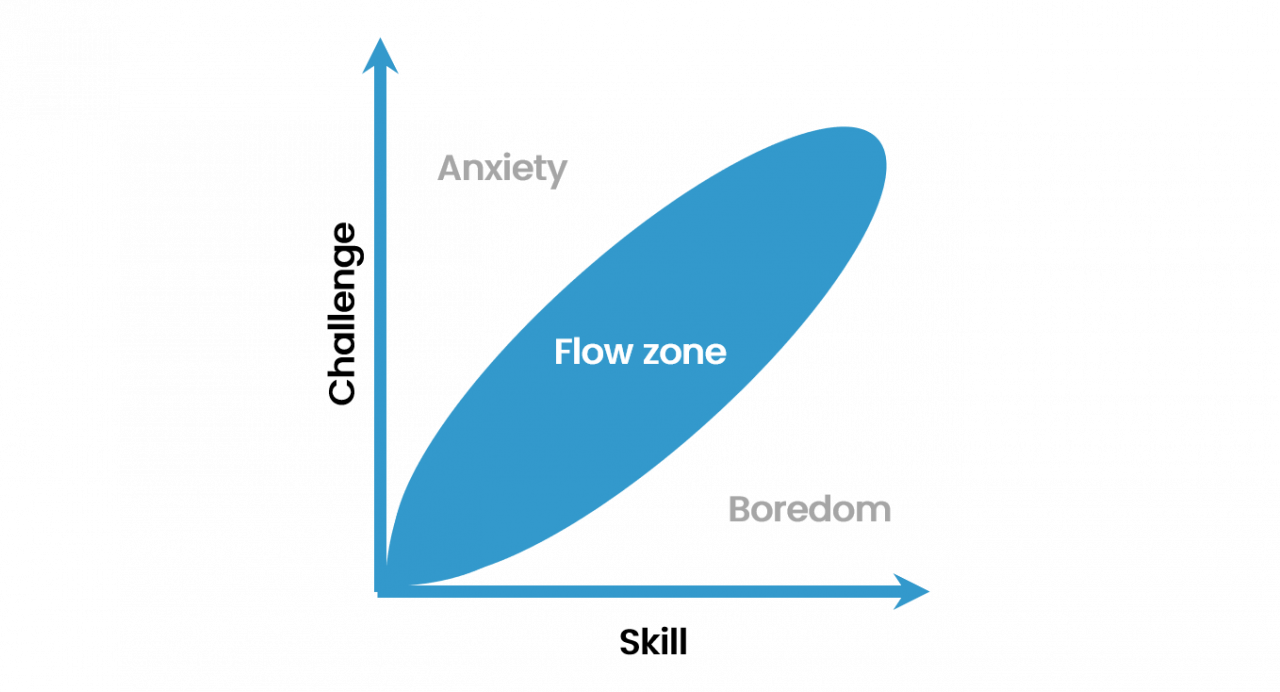The concept of “flow” is something which both Lefteris and myself found inspirational, long before we got together to start our company. This article tells the story of how flow became a central pillar of our working culture, and how our company got its name.

What is flow?
Flow is a psychological term which describes a certain state of consciousness: an optimal experience in which one’s attention is actively engaged and completely absorbed in the task at hand, often losing track of time. There is often a sense of discovery, a creative feeling of movement and the feeling of being in control. This is effectively what we mean when we say someone is “in the zone”.
The idea of flow was first introduced by the Hungarian-American psychologist Mihaly Csikszentmihalyi [1] in 1975. In his seminal book on the subject, he relates how high-performing individuals – like artists, athletes, musicians, chess masters and surgeons – all described their complete absorption and peak enjoyment in their respective activities: a state in which nothing else seemed to matter but the activity itself, which they would do for its own sake, simply because of how it made them feel.
He went on to study normal people doing everyday things, not just “experts” – and he found that flow was not limited to high-performers, but was experienced by people of all ages across the globe, in a wide range of cultural and economic settings.
Flow provides the ultimate motivation – intrinsic enjoyment brought about by the activity itself. Csikszentmihalyi goes as far as to propose that flow is the secret to happiness, a means of bringing the ecstasy of altered consciousness into everyday life.
Flow is an experience shared by rock climbers, gardeners, sky-divers, hairdressers, parcours traceurs, traffic wardens, surfers, improv artists, freestyle rappers, and software developers (and/or hackers) – as in the film “The Social Network”, which the young Facebook developers call being “wired in”.
Entering the zone
To enter a state of flow, there must be a balance between the skill level of the participant and the difficulty of the task. If a task is too easy, boredom ensues, whereas a difficult task given to someone who lacks the appropriate skills will simply cause anxiety.

Between these two undesirable outcomes is the “Goldilocks” area known as the “flow zone”: here we find the optimal combination of challenge and skill, leading to the peak experience of flow. There is a dynamic here: the challenge level allows skills to incrementally improve, so over time, the tendency is towards increased mastery and – if the challenge level stays the same – eventual boredom. A more nuanced model describes the 8 different mental states linked to different levels of skills and challenge.
Csikszentmihalyi discovered two other conditions which help to trigger flow states:
• Clear goals for the task at hand (knowing what to do)
• Clear and immediate feedback (knowing how well you are doing)
A conducive environment without distractions also helps – but it may be possible to screen out irrelevant stimuli when deep in flow.
Another important aspect which Csikszentmihalyi highlighted is the fact that individual perceptions of both challenge and goals can play a role in reaching flow: what might seem boring and unstimulating to one person might be viewed by another as captivating and interesting. In the same vein, an individual can transform dull activities into ones with flow potential by creating goals and challenges. This can be as simple as avoiding cracks in the pavement during a long walk, or involve wholesale gamification.
Flow at work
Lef and I realised that we wanted to bring as much flow into our working life as possible. Our previous experience working together in noisy, interruption-filled environments made us keenly aware of how much productivity is sacrificed when respect for individual concentration and states of high focus is missing from company culture. The damage is compounded when goals are unclear and feedback is ambiguous or missing.
So, when we started our own company, flow was high on the agenda.
One of our first decisions was what to call our new enterprise. We wanted to reference flow in the name, so after some deliberation, we chose “Evenflow” – a name with several layers of meaning:
• It describes the ultimate flow state: smooth, uninterrupted and consistent.
• It calls to mind a constant and rhythmic supply, and there are many things which we aspire to generate an “even flow” of: knowledge, ideas, projects, partnerships (and of course, cash)!
• It pays homage to Pearl Jam, a band representing the intersection of my and Lef’s rather different musical tastes (it’s also one hell of a jam).
As we built our start-up, we developed new habits which would gradually become part of our company culture: checking for a flow state before interrupting someone, setting clear goals, and making sure our feedback was immediate and unambiguous – firstly to one another, and then later to the members of our team.
We incorporated time tracking into our daily routine as a means of further improving our visibility of how we were spending our days. We chose Asana as our de facto task manager – together with shared Google calendars, this gave us a coordinated view of who was working on what.
Over the next five years, as our headcount steadily grew from two to eight, we developed these ideas into a full set of operational practices aimed at fostering, nourishing and safeguarding states of flow.
• Understanding flow: Every Evenflower receives a copy of Csikszentmihalyi’s Flow: as a welcome gift upon joining the company.
• Discovering our superpowers, skills and motivations: One of the questions we ask during our hiring interview is “what is your superpower?” We take time to understand the individual specialty skillsets of our team members and work on building them through challenging activities.
• Setting goals together: We have established a programme of goal-setting and review, designed to make the individual contributions to the bigger picture as clear and tangible as possible.
• Comfortable, quiet and healthy working environment: Everyone at Evenflow gets an adjustable standing desk, an ergonomic chair (and optional inflatable ball) and peripherals such as (optionally, low-noise) keyboard and mouse combinations and noise-cancelling headsets. We made sure that many of these items were delivered to our respective home offices during the lockdown. There is also a comfy lounge in our office, which we have used for freewheeling brainstorm sessions and project-specific “lock-ins” – but it seems that we won’t be using this room any time in the near future.
• Fast and responsive machines: Having your flow broken is bad enough, but its somehow worse if the reason is your sluggish computer. We try to minimise these disturbances by supplying our team with good quality laptops in the first instance, and keeping them nippy through good maintenance practices.
• Minimising distractions: We try to minimise or avoid unnecessary distractions as a matter of course – for example, by checking each other’s calendars before initiating contact, and minimising the number of instant messages we send to reduce pop-up notifications.
• Focused isolation: Anyone who wants to work undistracted can go into “focused isolation” – displayed as a calendar entry – which (barring emergencies or force majeure) we all duly respect.
• Reducing cognitive burden wherever possible: This applies to many of our company policies, for example, file hygiene, which aims to make finding and accessing files as effortless as possible through a standardised, well-observed folder structure.

• Productivity tools: We promote the use of productivity-enhancing software, such as Ditto for clipboard management or Screenpresso for screen capture. We also custom-built keyboard shortcuts (using AutoHotKey) to automate common tasks and functions. These small improvements may not save much time per instance of use, but they add up for very frequent tasks, and more importantly, they help to sustain flow.
Flow is – ultimately – a highly personal matter, dependent on each individual’s character, sense of challenge and skill, motivation and style of working. Our approach is to facilitate and encourage our team to seek and develop flow states, by making sure that the external factors help, rather than hinder this process.
We are still learning about practices, methods and tools for cultivating and sustaining flow states at work, and we intend to use this blog to catalogue and share our flow-finding experiences, amongst other things, such as showcasing our work through case studies and sharing our thoughts on developments in our fields of expertise.
If you have flow-related stories to share, suggestions on the best ways to get “in the zone”, or would like to give us feedback on this story, please get in touch.
[1] It’s pronounced “Six-cent-mee-hal-yee”; you’re welcome!


